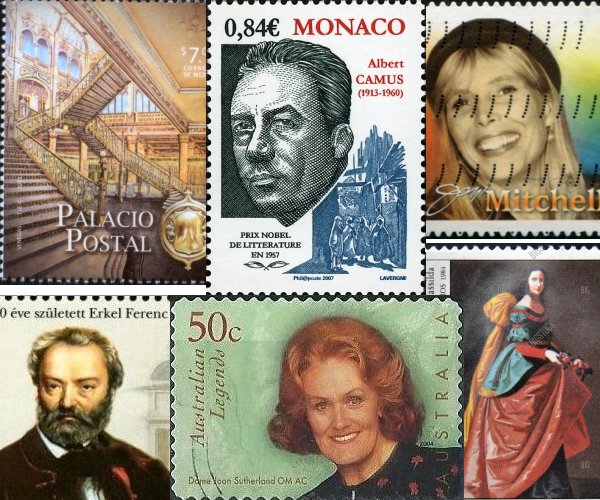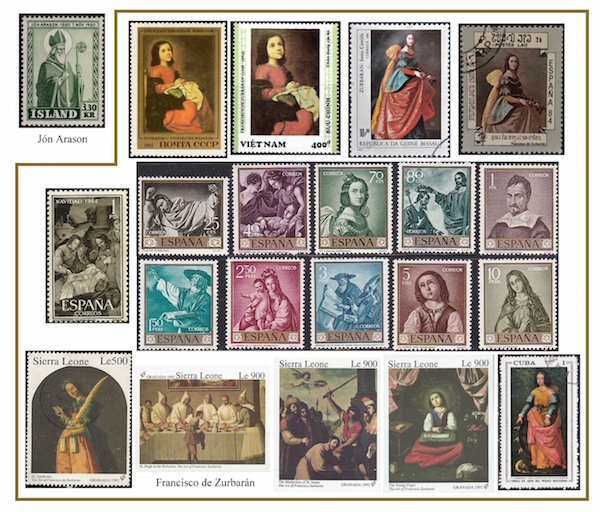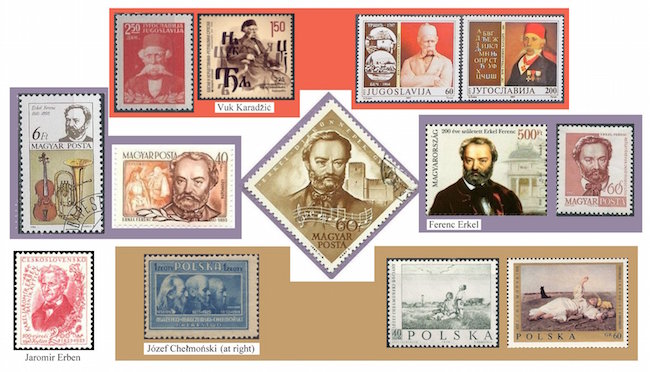The Arts on Stamps of the World — November 7
An Arts Fuse regular feature: the arts on stamps of the world.

By Doug Briscoe
Today’s headliners are Albert Camus and Joan Sutherland, but we offer, too, the usual assortment of poets and painters, composers and creators of all sorts.
First a brief salute to the Icelandic cleric Jón Arason (b. 1484), who died on this day in 1550. He was a Roman Catholic bishop who resisted the introduction of Lutheranism to the island, but for our purposes he was also a poet, and a newly updated volume of his religious verse was published as recently as 2006.
The Spanish painter Francisco de Zurbarán was baptized on November 7, 1598. He, too, is known mostly for his religious work, representations of biblical scenes, saints, and martyrs executed (pardon the pun) in such a manner as to earn Zurburán the sobriquet of the Spanish Caravaggio. It’s not known, however, whether Zurburán in fact ever saw any of the greater master’s work. As a child Francisco made charcoal drawings with enough talent that his father apprenticed him, aged 16, to an artist in Seville. Zurbarán produced two series of paintings for monasteries that drew the attention of the elders of Seville, who invited him to become a citizen. The next year, 1630, he was chosen as court painter to Philip IV. Within a decade or so, Zurbarán’s workshop was churning out large numbers of paintings for the newly opening South American market. He died on August 27, 1664. The rather large number of stamps representing his work is mainly due to two extensive sets devoted to his art, one issued by Spain in 1962, the other by Sierra Leone in 1992. But I was frankly surprised by the many other Zurburán stamps from other lands. Russia and Vietnam both issued stamps showing The Young Virgin Praying (1632-33), while Guinea-Bissau and Laos both selected St Isabel of Portugal (c1635). In the next row I present the entire 1962 Spanish set, preceded by a 1964 issue of a Nativity. Highlights from the set of ten include St Serapius (1628) at upper left and a Self-Portrait at upper right. The 5 peseta value shows a detail from another portrayal of The Young Virgin (c1632-3), which also was used for one of the Sierra Leonean stamps, placed directly beneath it. Preceding that stamp in the bottom row are St Apollonia (1636), St Hugh in the Refectory of the Carthusians (c1655), and The Martyrdon of St James (c1640). Finally, on a Cuban stamp from 1971 we see St Catherine of Alexandria (with her wheel). Zurburán also painted still-lifes, and here’s one: Still-life with Lemons, Oranges and Rose (1633).

The Serbian philologist and linguist Vuk Karadžić (7 November 1787 – 7 February 1864) is described by Wikipedia as “the major reformer of the Serbian language” for his standardization of the Cyrillic alphabet and the creation of a new dictionary. He also made a translation of the New Testament using the revised orthography. Karadžić was also important as a collector of folk songs and tales, deserving the designation the father of Serbian folklore studies. Goethe and Jacob Grimm were well acquainted with his work. He is remembered on stamps of Yugoslavia and Bosnia.
In order to avoid bad jokes about the character on Family Matters, pronounce Ferenc Erkel’s name as AIR-kel. That should quieten your tendency to frivolous hilarity. Erkel (1810 – June 15, 1893) is held in high regard in his native Hungary, where his operas are often performed. The most famous of them, Hunyadi László (1844), is revered as the quintessential Hungarian national opera, but his popularity has not extended beyond his homeland, and all of his stamps were issued by Hungary. Erkel was also an important conductor and pianist as well as a noted chess player. He even wrote a pantomime called Chess Game (1853), in which the dancers represent the pieces in an 81-move game. It was Erkel who introduced Berlioz to the anonymous 18th-century Rákóczi March, which Berlioz used in The Damnation of Faust, from which in turn Liszt made his various arrangements. Erkel’s “Himnusz” (Hymn) has been the national anthem of Hungary since 1844.

From Hungary to neighboring Czechoslovakia and from Erkel to Erben. Actually, poet Jaromir Erben (1811 – November 20 1870) would have been born into what was then the Kingdom of Bohemia. Music lovers owe him a great debt in that his folkloric poetry included pieces that gave inspiration to Antonín Dvořák, resulting in four great orchestral tone poems of 1896, full of moody and coloristic effects as well as delicious melodies. The poetry, a collection called A Bouquet of Folk Legends (or sometimes, A Bouquet of Flowers), had been published many years before, in 1853, with a second edition appearing in 1861, and indeed Dvořák had been aware of it for some time, as it also inspired his long cantata The Spectre’s Bride in 1884. (That same work would also be set by Bohuslav Martinů in 1932.) Other poems from the Bouquet gave rise to two works with narration by Zdeněk Fibich. (Both Martinů and Fibich have birthdays next month.) My favorite recordings of the Dvořák tone poems, The Noonday Witch, The Golden Spinning Wheel, The Wood Dove, and The Water Goblin, Opp.108-111, are probably those by Rafael Kubelík on DG, but the Chandos issue with Neemi Järvi, also splendid performances, comes with a detailed, point-by-point description of the “action” of each story in its booklet, and that enriches one’s appreciation of Dvořák’s music enormously. But be warned: the stories are all pretty grisly, what with dismemberments and child murders and suchlike.
And we go north to Poland (then part of the Russian Empire) and painter Józef Chełmoński (November 7, 1849 – April 6, 1914), who learned drawing from his father, then went on to more advanced study in Warsaw, both in a school setting and privately with Wojciech Gerson. Chełmoński lived in Munich from 1871 to 1874 and in Paris, where he had successful exhibitions, from 1875, visiting his homeland, Vienna, and Venice in the years that followed. The last 25 years of his life he was in Poland, not living quite long enough to see the restoration of his country as an independent nation. Two Polish stamps show his Storks (Bociany, 1900) and Indian Summer (Babie lato, 1875). Here, too, is a link to his Self-Portrait of 1902.
Carl Emil Paul Lincke (7 November 1866 – 4 September 1946) was a German operetta composer who enjoys a stature in Berlin equal to that of Johann Strauss for Vienna and Jacques Offenbach for Paris. He wrote “Berliner Luft” (“Berlin Air”), the unofficial anthem of Berlin, which is commonly played as an encore by the Berlin Philharmonic. (It comes from his 1899 operetta Frau Luna.) His other big hit is “The Glow-Worm” (from the 1902 operetta Lysistrata). Johnny Mercer’s adaptation of an earlier translation of that song was taken up with great success by the Mills Brothers in 1952.
We find ourselves back in Seville, as Flemish artist Eugeen Yoors (1879 – 1 April 1975), born in Antwerp, grew up there, learning Spanish and French, which must have been helpful when subsequently he studied at the École des Beaux Arts in Paris. Yoors traveled in Western Europe before settling in his birthplace in 1907. Together with the architect and painter Flor Van Reeth he was one of the co-founders of the art circle known as Streven. One of their exhibits was visited by the writer Felix Timmermans, with whom Yoors formed a lifelong friendship. In 1913 Yoors and Van Reeth established a workshop for building and decorative art called Le Scarabée d’Or. During the war he was in a refugee camp and made hundreds of drawings of soldiers. In the 20s he, Van Reeth, and Timmermans founded yet another artists’ association, De Pilgrim, this one based on Catholic progressivism. Yoors produced work in painting and engraving but is best remembered for his glass windows. The Belgian stamp of 1993 shows one of these. The New York artist Jan Yoors (1922–1977) was his son.
Next we turn to the most important Mexican architects of his day, Federico Ernesto Mariscal (1881–1971). He was a professor of architecture for sixty years (1909-69) and built theaters, public buildings, churches, and residences. Among many other books, he wrote one on the architecture of the Mesoamericans in 1928. After delays of many years, in 1934 Mariscal was responsible for completing work on the Palacio de Bellas Artes that had been started by Adamo Boari in 1901. Most of Mariscal’s work was on the interior, a view of which we can see on the stamp.
Another composer of operetta was the Bulgarian Yusuf (Yosif) Tsankov (7 November 1911 – October 21, 1971). Born into a well-to-do, polyglot merchant family, he wrote his first composition at the age of 11. Beside such operettas as Maya, Juan, Hang On, Jujie, and Golden Widow, held to be the first of their kind in Bulgaria, he wrote pop songs and music in various dance forms: waltzes, tangos, foxtrots, rumbas. Much of his work was lost in the bombing of Sofia in World War II, after which his music was frowned upon by the Communists as “bourgeois”. But in 1951, with help from Aram Khachaturian, he became managing editor of the state recording company Balkanton. He wrote some 500 pieces. From his teens, by the way, he was also a keen basketball player and coach and later possessed one of the richest stamp collections in Bulgaria.
Albert Camus (7 November 1913 – 4 January 1960) shows up on five postage stamps; on all but one of them, the one from France, his 1957 Nobel Prize is cited. On the one from Guinea-Bissau he is paired with Jean-Paul Sartre, as both men had won the prize and both were seen as existentialists, though Camus rejected the term. After Kipling, Camus, at 44, was the youngest man to win the prize in literature. He was killed in a car accident at 46.
The final row of our third collage today is devoted entirely to female vocalists. Chilean soprano Rayén Quitral (her full name was Rayén Quitral María Georgina Quitral Espinoza) was born 7 November 1916. She was of Mapuche-Picunche ethnicity and often dressed in native costume as an expression of pride in her indigenous roots. Her debut appearance was at the Central Theatre of Santiago in 1937. In 1941 at the Colón Theatre in Buenos Aires, she sang the Queen of Night in Mozart’s Magic Flute, a rôle for which she became internationally known (and in which guise she is shown on the stamp). She made a concert tour of Italy and France in 1950 and sang at Buckingham Palace in 1951. Retiring in 1967, she took up teaching singing “to young people of limited means”. Rayén Quitral died on 20 October 1979.

A more renowned soprano, born exactly ten years after Quitral, Dame Joan Sutherland (7 November 1926 – 10 October 2010) was born in Sydney, Australia, where she made her concert debut in Purcell’s Dido and Aeneas in 1947. Her stage debut (1951) was in the opera Judith, a work by the fine conductor Eugene Goossens. She performed at the Royal Opera House, Covent Garden, the following year and married the conductor Richard Bonynge in 1954. It was Bonynge who convinced her she should abandon her dream of being a Wagnerian soprano and specialize instead in the bel canto repertoire. From the time of her performance as Handel’s Alcina at La Fenice in 1960 Sutherland was known as La Stupenda. She first appeared at both La Scala and the Metropolitan Opera in 1961 and the next year was the first Australian to win a Grammy Award. She retired from the stage in 1990, but starred in a 1995 comedy film, Dad and Dave, with Leo McKern and Geoffrey Rush. An official biography appeared in 1994, written by British prime minister John Major’s wife, whose name just happens to be…Norma! Joan Sutherland died at her home in Switzerland a month shy of her 84th birthday.
Happy birthday to Canadian singer-songwriter and nine-time Grammy winner Joni Mitchell (born November 7, 1943). Her work has received accolades of a high order— Rolling Stone called her “one of the greatest songwriters ever”, and in a poll by the same magazine her 1971 album Blue was hailed as No. 30 on their list of “500 Greatest Albums of All Time”, the greatest by a female artist.
Wikipedia tells me that “the oldest musical organization in the United States” was founded on this date in 1786, and it happens to be the Stoughton Musical Society. Also on this day in 1929, the Museum of Modern Art opened in New York City.
I was surprised to find no stamp for French symbolist writer Jean-Marie-Mathias-Philippe-Auguste (7 November 1838 – 19 August 1889), better known by his title the comte de Villiers de l’Isle-Adam.
A graduate of the University of Massachusetts with a B.A. in English, Doug Briscoe worked in Boston classical music radio, at WCRB, WGBH, and WBUR, for about 25 years, beginning in 1977. He has the curious distinction of having succeeded Robert J. Lurtsema twice, first as host of WGBH’s weekday morning classical music program in 1993, then as host of the weekend program when Robert J.’s health failed in 2000. Doug also wrote liner notes for several of the late Gunther Schuller’s GM Recordings releases as well as program notes for the Boston Classical Orchestra. For the past few years he’s been posting a Facebook “blog” of classical music on stamps of the world, which has now been expanded to encompass all the arts for The Arts Fuse.
